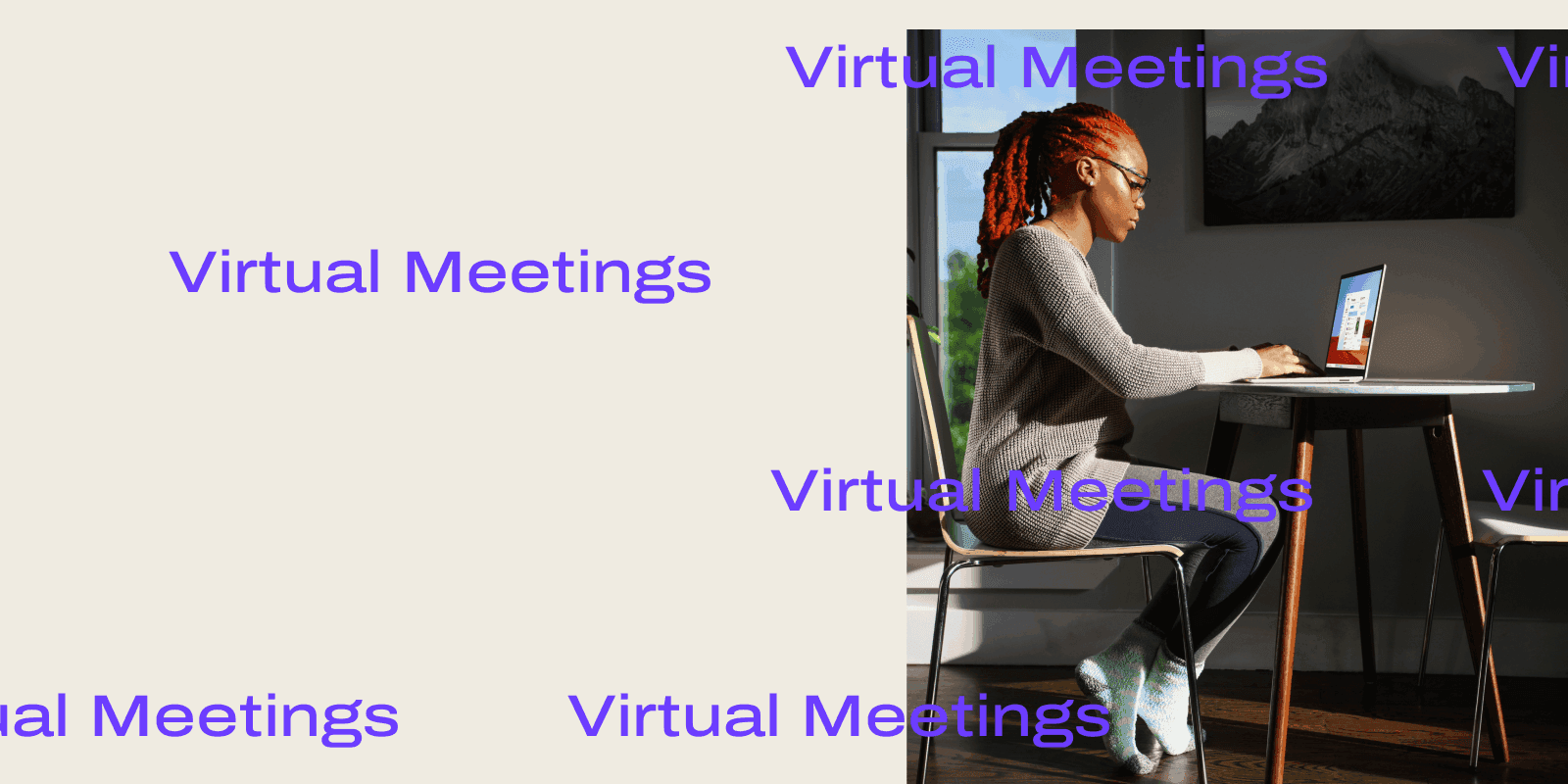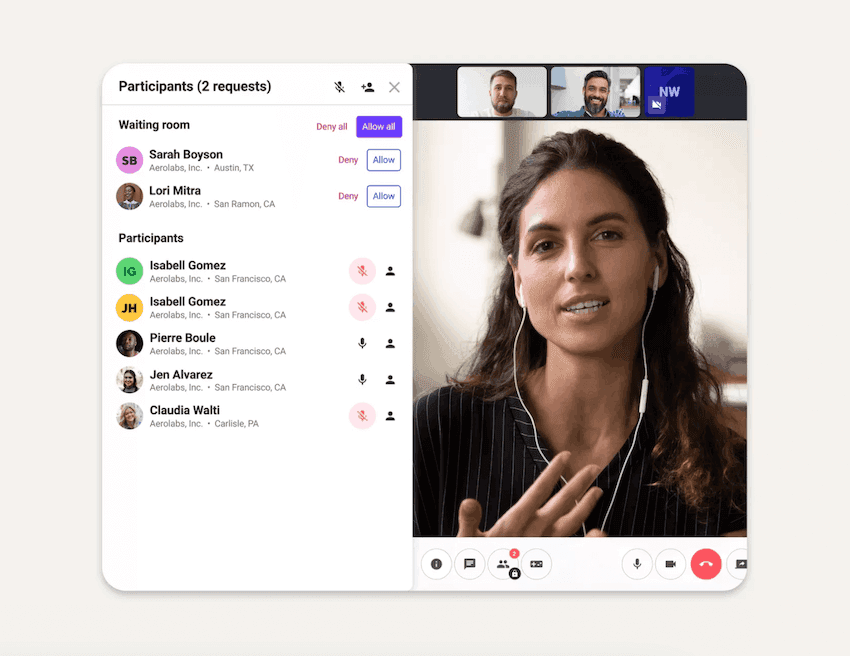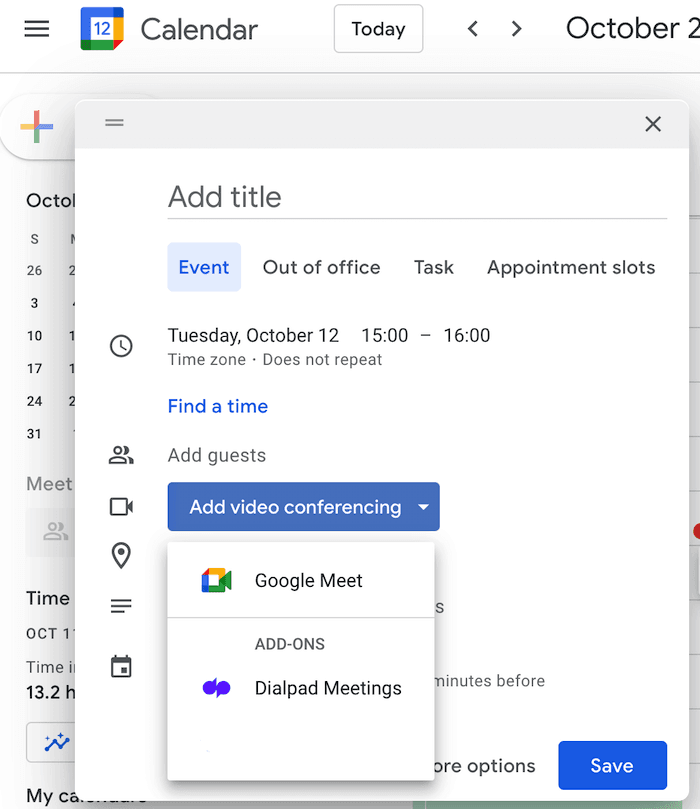Virtual meeting tips: Everything a remote team needs to know

Senior Product Marketing Manager

Tags
Share
Meetings are the bread and butter of business—they bring people together, inspire collaboration and spark interaction.
And with remote work becoming more popular, there’s a new way to meet face-to-face: through online meetings.
In this post, we’ll look at everything you need to know about having a productive virtual meeting, from tips for engaging your teammates on video conferences to features to look for in virtual meeting platforms, and more.
But first...
What is a virtual meeting, exactly?
The simple definition of a virtual meeting is essentially a team or 1-on-1 discussion that you have online rather than in-person. If your meeting participants can’t all be physically in the room together, then online meetings can give you that platform for including remote team members in discussions, brainstorm sessions, and more.
To run these digital meetings, you’d typically use virtual meeting tools that include features like screen sharing…

And security controls like virtual meeting rooms (so you can lock meetings and prevent meeting-crashers from joining):

3 common terms people use when talking about “virtual meetings”
Other than “virtual meeting,” there are three other terms that you might hear people use when they’re talking about meeting online:
Web conferencing
Some folks use “web conferencing” to refer to online meetings with more fancy functionality like real-time collaboration, virtual events, screen-sharing, and interactive activities—while “video conferencing” refers more commonly to a regular video call.
If you’re having a team meeting that involves some degree of collaboration or presentation of a project or design mockup, that’s web conferencing.
💻 Side note:
Web conferencing and webinars aren’t the same thing—they’re different in the sense that webinars typically involve one-way communication (someone’s presenting to a group of people) while web conferences can integrate messaging, video, and presentations into a two-way form of communication.
Teleconferencing
Traditionally, teleconferencing revolves around meetings that have audio, but no video. It’s generally more accessible since you don’t need a webcam or other complicated technology. The downside, of course, is you can’t see everyone’s body language and physical cues.
While this creates a barrier for non-verbal communication, teleconferences are still a good option for teams with internet connection issues or large numbers of participants (because it requires less bandwidth than virtual meetings with video).
Video conferencing
This is probably the most common term you’ll hear today when people talk about a conference call. Generally, video conferences are just online meetings that use video. Team virtual meetings are great for groups that aren’t too big, and all participants have a decent Internet connection. If that’s the case, being able to see each other face-to-face and getting those body language cues in meetings is probably your best option.
How to prepare for a successful virtual meeting
Prepping for a virtual meeting is pretty simple. It’s a little more work if you’re hosting, but here are three things to check first if you want to run a successful virtual meeting.
1. Internet connection
This is the most important thing, so we’re putting it first. Make sure everyone’s Internet connection is stable for better call quality—and be sure to have a back-up plan in case things go south!
No matter how awesome your virtual meeting platform is, you need a good Internet connection. That’s a must-have. If you’re looking to upgrade, T-Mobile has a partnership with Dialpad that gives you lightning-fast 5G Internet along with a unified communications platform (virtual meetings, phone calls, messaging, and more—all in one app).
2. Scheduling
Scheduling is an essential component to effectively and successfully meeting virtually, so make sure you send invites out ahead of time. If your virtual meeting platform integrates with Google Calendar or Microsoft Outlook, this makes things easier.
For example, Dialpad integrates with both, which means it’ll automatically create a virtual meeting link when you create an event:

If you have a remote or global team then as a courtesy, try to schedule your virtual meeting that takes into consideration everyone’s time zone.
Another neat thing you can do in Dialpad is automatically remind folks to show up for your online meeting with the dial-out feature. If you turn this feature on, it’ll automatically “dial out” to your meeting participants when your meeting starts (just in case someone forgot about it).
3. Agenda
If you’re the host or organizer of a virtual meeting, one key thing to remember is the meeting agenda! It's one of the most important parts of a productive meeting.
Before you set up a conference call, make sure every team member knows what’s on the agenda and what they’re expected to contribute. Make sure all documents and presentations are linked in your invite, and if it’s a bigger project, you might want to schedule a follow-up after the meeting, too.
💻 Side note:
If it sounds like a lot of manual work, some digital meeting platforms have a post-call summary feature that takes this off your plate. For example, Dialpad automatically sends a post-call email to all your meeting participants with a transcript of the meeting, action items, and more.
3 best practices for virtual meetings
1. Mind your etiquette
In a virtual meeting, many of the same rules of in-person meetings apply.
You wouldn’t show up for a meeting late every time, or talk over other people in a meeting room, right? Same goes for virtual meetings.
Here’s a quick refresher on some dos and don’ts:
Mute your mic when you’re not speaking (or try to be in a quiet location to reduce background noise and distraction)
Dialpad's virtual background feature lets you choose a custom background or blur your background just in case you didn't have a chance to clean up your office space:

Come prepared and fully up-to-date with the meeting agenda
If you’re the facilitator, introduce everyone, especially if there are new attendees on call
Avoid multitasking (no looking at phone or opening up and responding to emails)
Don’t interrupt others while they’re speaking
2. Encourage engagement
Keeping everyone engaged on a virtual call is a little tricker because everyone is physically separated and let’s face it, there are way more distractions at home. Here are a few ways to keep everyone on your team engaged and responsive:
Catch up on life to break the ice
If you have a few minutes at the beginning, you might want to begin your virtual meeting with casual conversation to get everything warmed up and in the mood for discussion and collaboration.
(This is especially important if there are new hires or clients on the call as you’ll want to make them feel comfortable.)
Designate tasks
If people aren’t 100% clear on what they’re supposed to be doing on the call, they’re more likely to zone out. To mitigate this, designate tasks ahead of time via a reminder or email the day before the call, clearly outlining what everyone’s responsibility is at the meeting.
Besides the usual tasks (like who you’ll be inviting for the presentation), you could also set smaller tasks so everyone feels like an active participant of the call. This could be as simple as tasking team members with responsibilities such as making note of follow-up tasks, organizing break-out rooms, and keeping the agenda on track.
3. Have takeaways and clear follow-up tasks
Virtual meetings might seem straightforward—and they are—but they’re not always easy to keep productive.
The best way to make sure you’re making the best use of everyone’s time in online meetings is by having clear next steps. What did you decide collectively? Who is responsible for what? These are the types of questions you should be answering in meetings. Otherwise, you may reconsider whether you need that meeting in the first place. (One underrated tip for having more productive meetings? Have fewer meetings.)
What are the benefits and drawbacks of virtual meetings?
The increasing popularity of remote and hybrid work may have pushed virtual meetings into the limelight, but like with anything else, there can be drawbacks to having online meetings if you’re not careful.
Benefits
It’s cheaper
Traditionally, meetings would usually bite into your wallet a little more than you bargained for. You’d have to pay for travel, sometimes even covering for your team to make it to locations—and let’s not forget about the impromptu breakfast / brunch / lunch / drinks.
Pretty costly at the end of the day, but with virtual meetings, all those costs are virtually eliminated. Yes, you’ll have to pay for a service provider or conferencing software, but you’ll be saving much more money in the long-term. If you want to cut down on your overall expenses, having virtual meeting options is a cost-effective investment.
You can involve more people
The great thing about virtual meetings is that pretty much anyone in any part of the world can join your meeting. This opens up way more opportunities globally with hiring and acquiring customers, since you’ll be able to communicate with people who would otherwise be too far away or too expensive to reach.
(The only thing you’ll have to be considerate of is time zones and scheduling those online meetings to fit everybody’s individual schedule.)
You’re reducing your carbon footprint
By moving your meetings to a virtual environment, you’ll be cutting down on costs and cutting down on your carbon footprint. (Think of all the small things you usually do with in-person meetings—it’s mainly plane travel.)
Most businesses have a pretty large carbon footprint, and taking on more online meetings is a good way to contribute towards a greener future.
It’s more time-efficient
Unlike in-person meetings, virtual meetings eat up very little of your team’s time. Since they won’t need to travel to the office or get roped into a brunch/lunch/drinks meeting, they’ll be able to retain the most important information and move onto getting the real work done. Online meetings essentially eliminate all the faff that comes with in-person meetings, allowing your team to be more productive and efficient.
You’re free to take online meetings from anywhere
Want to work from a cabin on the lake? Or a coffee shop? As long as it’s relatively quiet, you can join and host online meetings from pretty much anywhere. And you can do it on any device too. Computers, mobile devices—and yes, that includes iPads—it depends on your digital meeting platform, but most will work across different devices.
Drawbacks
Engagement and participation are trickier
While virtual meetings and video chats can be more engaging, it’s still not quite the same as face-to-face meetings in a meeting room. It’s the next best thing, for sure, but humans are great at pretending to listen while checking social media—and even better at multitasking.
And then there are things like background noise and distractions at home (you just can’t control when deliveries arrive at your door), which are unavoidable parts of taking virtual meetings from home.
One way to alleviate this is to check in with your attendees or call on them from time to time to see if anyone has questions and zoom in on specific issues, so everyone knows that they might be expected to speak up at any time.
Technical issues might crop up.
No matter what video conferencing software or collaboration tools you use, you’ll probably experience some kind of technical issue once in a while. Your Internet connection might cut out, puppies chew through cables, and your headset for conference calls just randomly stopped working…
(Since virtual meetings rely on a stable internet connection, there’s always the chance you and your team might run into connection issues, though these can usually be easily resolved.)
Plus, not all your team members will be familiar with video conferencing and might need some help getting set up.
How to find the best virtual meeting platform
Of course, there’s no perfect platform for everyone—the one you choose will depend on your individual business needs. You might only be looking for a virtual platform for meetings or you might want a platform that hosts a mix of cloud contact center solutions and virtual meeting capabilities.
Here are some other things to consider:
Ease of use
How easy is it to set up and install your new virtual meetings software? Does your platform come equipped with handy guides and a line for support? These are important questions to ask because otherwise, you could run the risk of a lengthy installation process.
More advanced features
This one is a mixed bag because sometimes, you just don’t know what you need until you see it in action. Always try the free trial or get a demo to get a good idea of what a virtual meeting software can actually do.
For example, if you do customer interviews via online meetings, you might find real-time transcripts useful because your team can review those later and glean insights from the conversations. Dialpad, for example, comes with real-time transcriptions using its proprietary artificial intelligence technology:

Capacity and scalability
Before making any hard and fast choices, make sure your platform provider can actually grow with you. If you’re looking to host meetings with 80+ people, for instance, not all platforms will have the capacity to take you on.
Is it easy to add (and remove) users on your own without IT help?
Not all platforms are easy to use, so make sure you check for this when you’re trying out different options.
Customer support
This is another big one to consider. Not all digital meeting platforms have worldwide support or phone support, so if that’s important to you, ask about support options (and check out their Help Center database to see if it’s thorough and if it allows you to find answers easily on your own).
Want to have better virtual meetings?
Try Dialpad for free! You get unlimited video meetings, screen sharing, in-app security controls, and more. Or, take a self-guided interactive tour of the app on your own first!
